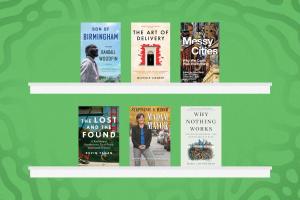 Read More
Read More
6 summer reads for urban innovators

Listen to This Article
If there are two plotlines that resonate with every local leader, they are that making government work well is a nonstop challenge and that the best ideas often come from the outside. This collection of new books reflects both realities by spotlighting stories and strategies that demonstrate how to make cities more effective and how to better connect them to what residents need. From an Alabama mayor’s moving story about reimagining government in his hometown to lessons on improving public services from the United Kingdom, these works offer something to any city innovator looking to raise their game.
Son of Birmingham
By Randall Woodfin and Edward T. Bowser
In this memoir, Mayor Randall Woodfin of Birmingham, Ala., outlines leadership principles that feel perfectly calibrated to this moment in public life. But first, he makes city leadership look fun, infusing the tale of his ascent from prosecutor to education official to mayor with a steady diet of playful references to his favorite hip-hop artists. Then he emphasizes the need for local government to be more responsive. Recalling how his own start bagging groceries helped prepare him for a laser focus on customer service, he details the core values all of his staff are imbued with: customer service, efficiency, effectiveness, transparency, and accountability, or CEETA. What emerges is a hopeful portrait of how a new generation of city leaders can make government a force for even more rapid progress.
Why Nothing Works: Who Killed Progress—and How to Bring It Back
By Marc J. Dunkelman
Like Ezra Klein’s and Derek Thompson’s book Abundance, Marc J. Dunkelman’s Why Nothing Works digs into why it’s so difficult for governments (including cities) to achieve big things, like large-scale infrastructure or housing at scale. Dunkelman applies particular focus on the history of progressivism in the United States and the tension between two impulses: the need to make government strong enough to deliver, and the need to prevent abuses of power. In his view, the latter impulse and the restrictions on swift action that come with it have served to impede state capacity, which risks undermining faith in government. His prescription: giving skeptics of ambitious new undertakings a “voice but not a veto.” In a city context, that might mean finding ways to be more deliberate in interactions with residents, moving from engagement for engagement’s sake to strategically channeling it toward concrete and achievable goals.
The Art of Delivery: The Inside Story of How the Blair Government Transformed Britain’s Public Services
By Michelle Clement
This deep-dive into the creation, behind-the-scenes work, and impact of the British national government’s first-ever Delivery Unit is chock-full of insights for cities. Established under then-Prime Minister Tony Blair, the Delivery Unit was essentially a team inside the government that monitored and accelerated progress in a select few core services, such as transit, health, and public safety. Michelle Clement’s protagonist is Michael Barber, the civil servant who led the Unit and went on to found Delivery Associates, which helps cities across the world build up their capacity to tackle challenges. We watch as Barber builds strong relationships across agencies so he and his new team are viewed as partners and not interlopers. That kind of strategic navigation of the political landscape (in this case, inside the machinery of government) will always be critical when city leaders start something new.
Messy Cities: Why We Can’t Plan Everything
By Various Authors
Cities will always grapple with disorder and the best ways to manage it. But one core message embedded in this collection of 43 essays is that it can be helpful for residents and local leaders alike to consider when that “mess,” whether a glut of street vendors or a complicated traffic intersection, is actually an asset. The thinking is that disorganization actually offers residents and communities the opportunity to pursue their own hyperlocal innovations. One example: a makeshift “beach” established in a vacant lot by residents of Toronto during the pandemic that came to serve as a beloved gathering space and was ultimately embraced by city leaders, including then-Mayor John Tory.
Madam Mayor: Love and Loss in an American City
By Stephanie Miner
Stephanie Miner’s two terms as mayor of Syracuse, N.Y., are the anchor for this in-depth account of a local leader pushing for practical solutions to longstanding problems. Through the Bloomberg Philanthropies-funded Innovation Team (i-team) program, she expands her administration’s capacity to use data, tackling everything from potholes to leaky water pipes with a sharp focus on results. While she sees value in public-private partnerships, Miner also argues for keeping core city functions in public hands, warning against over-reliance on outsourcing. Underpinning it all is her belief in the power of cities to drive meaningful change. “Local governments exist to solve problems,” she writes, “and can do so if supported and allowed to be creative.”
The Lost and the Found: A True Story of Homelessness, Found Family, and Second Chances
By Kevin Fagan
Homelessness is among the most persistent challenges confronting local governments today. While many cities struggle to make meaningful progress, journalist Kevin Fagan offers a deeply human perspective, vividly documenting the lives of two unhoused people, Rita and Tyson, in San Francisco. Through their stories, he moves beyond familiar statistics and policy debates to provide insight into what those experiencing homelessness genuinely need, want, and respond to. Local leaders will find here not just empathy, but clear evidence of why effective solutions require community connection, meaningful outreach, and approaches centered on families, not just individuals.

